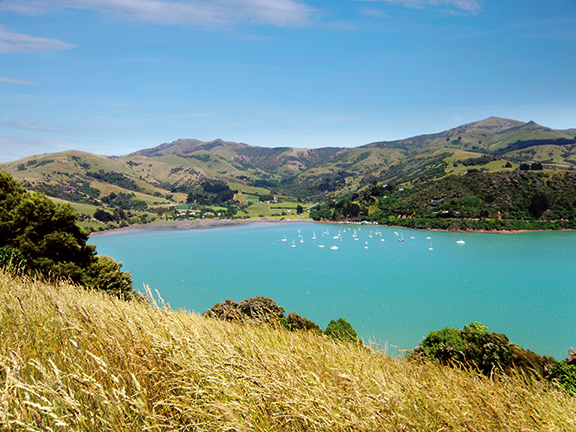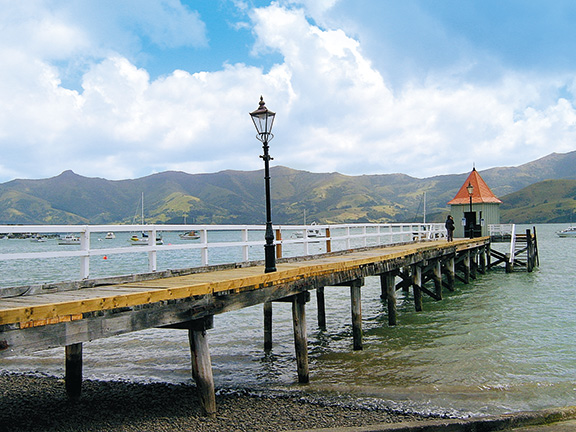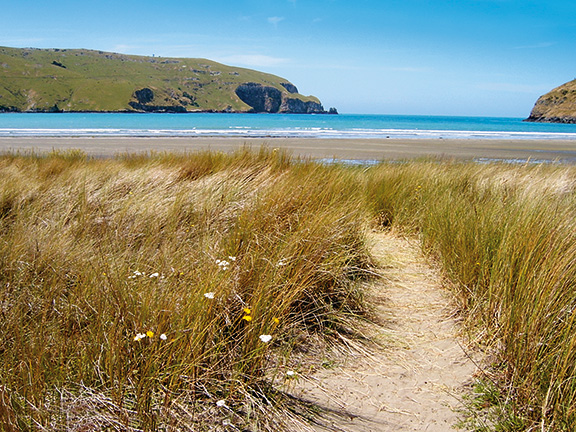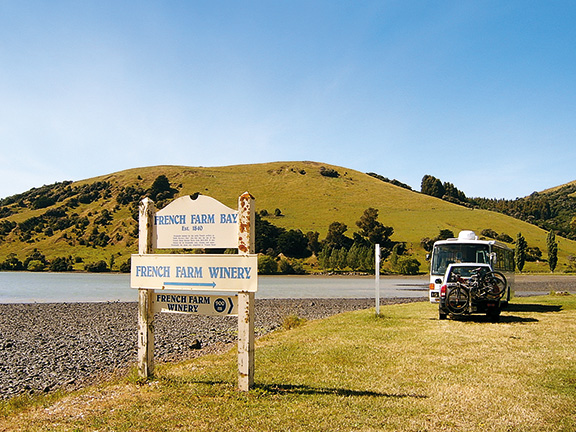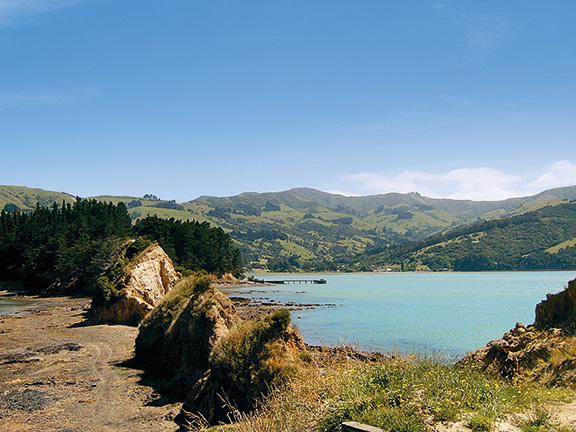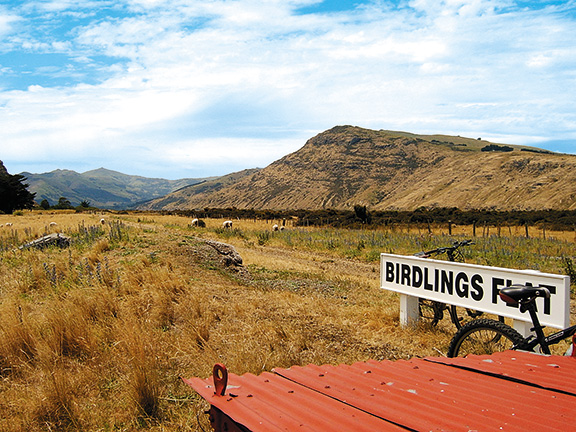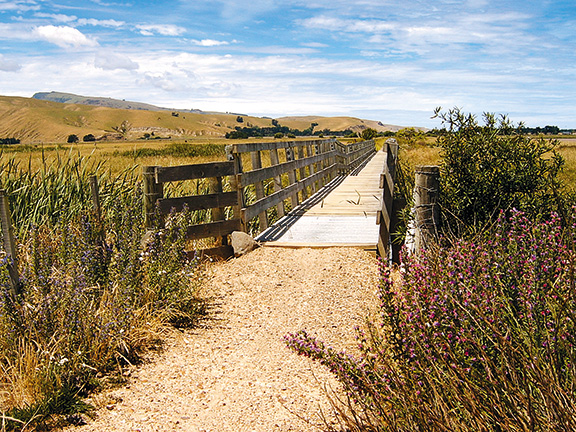Banks Peninsula was formed by the eruptions of volcanoes. The caldera of one formed Akaroa Harbour; the other, Lyttelton Harbour. Narrow bays run inland between mountain ranges right around the peninsula. Captain Cook thought it was an island and eons ago it was – until glaciers pushed moraines that joined the mountainous area to the mainland plains.
Visiting Akaroa
The township of Akaroa is named after the harbour it nestles beside (the Maori name means 'long harbour'). Almost splitting the peninsula in half, the harbour provides safe anchorage for ships and boats. Now the boats mainly cater for tourists but two hundred years ago it was whalers and sealers who sought sanctuary at Akaroa.
Maori were the first inhabitants. They named the peninsula Te Pataka o Rakaihautu ('the great storehouse of Rakaihautu'). There were three waves of migration: first the Waitaha (possibly as early as 850 A.D.), then Kati Mamoe and finally Ngai Tahu who lived on the peninsula in the seventeenth century.
Captain Cook named the area Banks Island in honour of the Endeavour's botanist, Joseph Banks, in 1770 – but the first Europeans to live on the peninsula were whalers who began basing their enterprises there in the early 1800's.
In 1830 the captain of the British brig Elizabeth transported the fearsome Ngati Toa chief Te Rauparaha and his warriors, who used muskets against the local Maori population – massacring them. A consequence of this tragedy was the signing of the treaty of Waitangi in 1840, which also pre-empted the colonisation of the Banks Peninsula by the French.
While the first shipload of French colonists waited out adverse winds in Pigeon Bay the British raised their flag near Akaroa. However the French colonists who settled here have given the area its unique French flavour.
The village of Akaroa maintains its French feel. The street and shop names are in French and the many restaurants and shops celebrate the French heritage. For those who want to investigate Akaroa's unique history there is the Museum to peruse, while the Information Centre has a series of brochures including the 'village walk'.
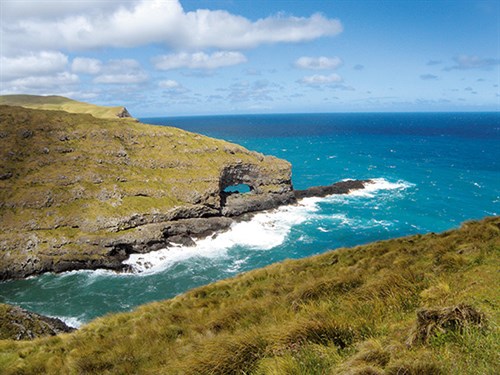
Banks Peninsula walking tracks
The Banks Peninsula has a multitude of walking opportunities. We walked a couple of contrasting one- hour tracks; one out in the open on Onawe Peninsula, the other through a 'goblin forest' recalling Tolkien's Middle Earth.
The Onawe Pa peninsula walk starts at Barrys Bay at the head of the Akaroa Harbour. The peninsula starts on a beach and rises steadily to a summit of 108 metres at what was the pa site.
The 360 degree views seen today are stunning, but the Ngai Tahu of 1830 would have been chilled by the sight of their advancing enemies. Unable to defend their pa with traditional weapons they were slaughtered by Te Rauparaha, who then instigated a cannibal feast on the beach. Maori ask that visitors respect the nature of the peninsula by not eating on the walk.
From the beach a narrow ridge leads to the slopes of the peninsula. The track is easy to follow as the grass is mown in a wide strip. There are side tracks too; one shows old Maori fishpond traps still visible in the water. At the pa site we looked across to French Farm Bay where our bus was freedom parked, just a tiny white dot in the distance.
We returned via a loop track from the summit which passes through manuka bush along the eastern side of the peninsula. Back at the beach it is interesting to examine the cliffs and rock pools at low tide, as there are unusual swirling patterns of red in the rocks here.
Otepatotu Scenic Reserve has a quite different feel to the now peaceful, open, Onawe Peninsula with its wide views. Access to the reserve is along the Akaroa Highway to Hilltop then along the Summit Road. The car park and picnic area is midway between Okains and Le Bons Bays. The walk begins by plunging upwards through bush to a lookout point on the bluffs.
Then onwards and upwards again the track climbs through a forest of mountain totara to the summit of Lavericks Peak (755 metres). As we got closer to the summit the forest began to feel more mysterious with sheets of moss hanging from the trees. It was easy to imagine elves and orcs peering out at us.
The information brochure describes this part of the track as having a 'goblin forest' atmosphere so we weren't the only ones to feel the magical vibes. Maori may have felt the same as a translation of Otepatotu is 'place of the faries'. The original inhabitants of the area, the Waitaha, were sometimes called by later Maori 'the fairy people'.
After enjoying the views at the summit we took the loop track down through a gully of native fuchsia. This part of the track was full of darting bellbirds which we tried, mostly unsuccessfully, to photograph. Their calls, along with those of some tui, made the track sound something like it might have done when those early fairy folk passed that way.
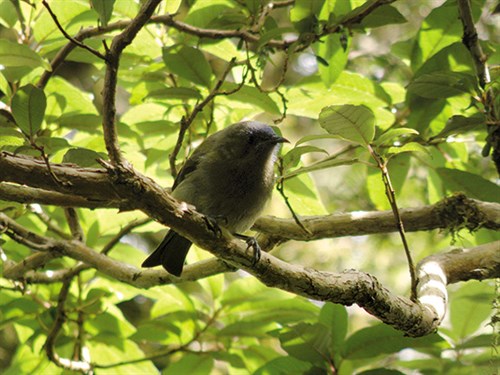
Christchurch to Little River Rail Trail
It was hard to leave the harbour-side views we had all to ourselves at French Farm but wanting to experience a part of the Christchurch to Little River Rail Trail, we moved on to Little River settlement where NZMCA members can park up behind the pub for no charge if you have drinks or a meal.
The Christchurch to Little River Rail Trail goes from Hornby on the outskirts of Christchurch to Little River, although some parts of it are not yet complete. The first section of the trail was opened in 2006 and the latest in 2012. The total distance is almost 50km, but we cycled part of it – a leisurely three hours cycling from Little River to Lake Ellesmere and back.
The old railway station in Little River, originally opened in 1886 and restored by volunteers, is home to a small museum, craft shop and a tourist information centre. There are brochures about the trail available here and a cafe and gallery next door.
Although we took our car along many of the peninsula's windy and mountainous roads and visited several beautiful beaches as well as enjoying the harbour and the French ambiance of Akaroa village there is much more to see on Banks Peninsula.
We will definitely return on a road trip again in the future.
More information
There is a variety of motorhome accommodation on the Banks Peninsula. We stayed at the Little River Hotel which has space at the rear for several motorhomes. We also freedom camped at French Farm Bay.
Akaroa Visitor Information Centre is located at 120, Rue Jolie, Akaroa.
Find more amazing New Zealand road trip destinations.

